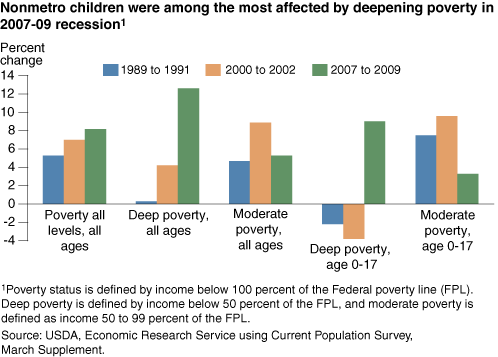Recession in 2007-09 Widened and Deepened Nonmetro Poverty
- by Tracey Farrigan
- 6/16/2011
Economic recessions invariably reduce incomes as employment levels fall, but there is strong and consistent evidence that the weight of recession falls most heavily on those at the bottom of the income distribution--the deep poor--who find it hardest to afford basic necessities and ensure their well-being. The 2007-09 recession was particularly severe in the depth of poverty it engendered. Relative to previous recessions, those residing in nonmetro areas, particularly children, were among the most affected by deepening poverty.
According to Census Bureau Current Population Survey data, the number of people living in poverty increased 17 percent between 2007 and 2009 to 43.6 million. In addition, the proportion of the population with annual income below the Federal poverty line increased to 14.3 percent in 2009, up from 12.5 percent in 2007 and the highest poverty rate since 1994. While these estimates indicate that poverty rose during the 2007-09 recession, they do not reflect the depth of poverty for those most affected. Examining increases in the number of people in deep poverty--defined as having income below 50 percent of the Federal poverty threshold ($21,945 for a family of four in 2009)--provides a clearer picture of how severely the 2007-09 recession affected low-income nonmetro residents.
The number of nonmetro residents living in poverty increased more than 8 percent between 2007 and 2009 to 8.1 million (a 16.6-percent poverty rate). Of these, an estimated 3.3 million (6.7 percent of the nonmetro population) were in deep poverty in 2009, up nearly 13 percent from 2007. The number of nonmetro residents living in poverty rose markedly in the previous two recessions as well (as measured by 1989-91 and 2000-02 annual data). Yet, the change in the deep poverty count was substantially higher during the 2007-09 recession ( see chart). The number of nonmetro children in poverty also increased in all three recessionary periods. However, the number of nonmetro children in deep poverty decreased in the previous two recessions, while it increased by 9 percent from 2007 to 2009. In comparison, the number of moderately poor (50 to 99 percent of the Federal poverty threshold) nonmetro children increased by 3.3 percent.
This article is drawn from:
- Rural Poverty & Well-Being. (n.d.). U.S. Department of Agriculture, Economic Research Service.


